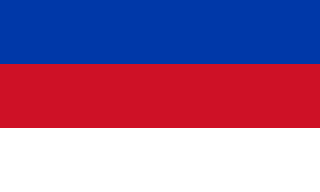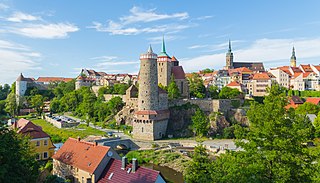
The Slavic languages, also known as the Slavonic languages, are Indo-European languages spoken primarily by the Slavic peoples and their descendants. They are thought to descend from a proto-language called Proto-Slavic, spoken during the Early Middle Ages, which in turn is thought to have descended from the earlier Proto-Balto-Slavic language, linking the Slavic languages to the Baltic languages in a Balto-Slavic group within the Indo-European family.

The Sorbian languages are the Upper Sorbian language and Lower Sorbian language, two closely related and partially mutually intelligible languages spoken by the Sorbs, a West Slavic ethno-cultural minority in the Lusatia region of Eastern Germany. They are classified under the West Slavic branch of the Indo-European languages and are therefore closely related to the other two West Slavic subgroups: Lechitic and Czech–Slovak. Historically, the languages have also been known as Wendish or Lusatian. Their collective ISO 639-2 code is wen.

Cottbus or Chóśebuz is a university city and the second-largest city in the German state of Brandenburg after the state capital of Potsdam. With around 98,000 inhabitants, it is the most populous city in Lusatia. Cottbus lies in the Sorbian settlement area of Lower Lusatia, and is the second-largest city on the River Spree after Berlin, from which it is situated around 125 km (78 mi) upstream. The city is located on the shores of Cottbus Eastern Lake, which will be Germany's largest artificial lake by surface area when flooding is completed.

Sorbs are an indigenous West Slavic ethnic group predominantly inhabiting the parts of Lusatia located in the German states of Saxony and Brandenburg. Sorbs traditionally speak the Sorbian languages, which are closely related to Czech, Polish, Kashubian, Silesian, and Slovak.

Lusatia is a historical region in Central Europe, split between Germany and Poland. Lusatia stretches from the Bóbr and Kwisa rivers in the east to the Pulsnitz and Black Elster rivers in the west, and is located within the German states of Saxony and Brandenburg as well as in the Polish voivodeships of Lower Silesia and Lubusz. Lusatia's central rivers are the Spree and the Lusatian Neisse, which constitutes the border between Germany and Poland since 1945. The Lusatian Mountains, separate Lusatia from Bohemia in the south. Lusatia is traditionally divided into Upper Lusatia and Lower Lusatia.
ISO/IEC 8859-2:1999, Information technology — 8-bit single-byte coded graphic character sets — Part 2: Latin alphabet No. 2, is part of the ISO/IEC 8859 series of ASCII-based standard character encodings, first edition published in 1987. It is informally referred to as "Latin-2". It is generally intended for Central or "Eastern European" languages that are written in the Latin script. Note that ISO/IEC 8859-2 is very different from code page 852 which is also referred to as "Latin-2" in Czech and Slovak regions. Code page 912 is an extension. Almost half the use of the encoding is for Polish, and it's the main legacy encoding for Polish, while virtually all use of it has been replaced by UTF-8.
Upper Sorbian, occasionally referred to as "Wendish", is a minority language spoken by Sorbs in Germany in the historical province of Upper Lusatia, which is today part of Saxony. It is grouped in the West Slavic language branch, together with Lower Sorbian, Czech, Polish, Slovak and Kashubian.
Lower Sorbian is a West Slavic minority language spoken in eastern Germany in the historical province of Lower Lusatia, today part of Brandenburg.

Bautzen or Budyšin, until 1868 Budissin, is a town in eastern Saxony, Germany, and the administrative centre of the district of Bautzen. It is located on the Spree river, is the eighth most populous town in Saxony, and is the seat of Saxony's largest district. Bautzen lies in the bilingual Sorbian settlement area of Lusatia, and is Lusatia's third-largest town after Cottbus and Görlitz, as well as the second-largest town in Upper Lusatia.

The West Slavic languages are a subdivision of the Slavic language group. They include Polish, Czech, Slovak, Kashubian, Upper Sorbian and Lower Sorbian. The languages have traditionally been spoken across a mostly continuous region encompassing the Czech Republic, Slovakia, Poland, the westernmost regions of Ukraine and Belarus, and a bit of eastern Lithuania. In addition, there are several language islands such as the Sorbian areas in Lusatia in Germany, and Slovak areas in Hungary and elsewhere.
The Sorbian alphabet is based on the ISO basic Latin alphabet but uses diacritics such as the acute accent and the caron, making it similar to the Czech and Polish alphabets. The standard character encoding for the Sorbian alphabet is ISO 8859-2 (Latin-2).
A mixed language is a language that arises among a bilingual group combining aspects of two or more languages but not clearly deriving primarily from any single language. It differs from a creole or pidgin language in that, whereas creoles/pidgins arise where speakers of many languages acquire a common language, a mixed language typically arises in a population that is fluent in both of the source languages.

Ź is a letter of the Latin alphabet, formed from Z with the addition of an acute accent. The letter appears in Polish, Montenegrin, Lower Sorbian, Upper Sorbian, Emiliano-Romagnolo, Wymysorys and Brahui, as well as in the Belarusian Latin alphabet, Ukrainian Latin alphabet and Romanized Pashto.

Serbin is an unincorporated community in southwestern Lee County, Texas, United States. Located about 50 miles (80 km) east of Austin, it was originally established as Low Pin Oak Settlement by Sorbian (Wendish) immigrants to Texas in the mid-1850s. The community's name was changed to Serbin, meaning "Sorbian land" in the Sorbian language, prior to 1860. The West Slavic Sorbs are distinct from the South Slavic Serbs, although the names of the two Slavic ethnic groups probably have a common origin.

The official language of Germany is German, with over 95 percent of the country speaking Standard German or a dialect of German as their first language. This figure includes speakers of Northern Low Saxon, a recognized minority or regional language that is not considered separately from Standard German in statistics. Recognized minority languages have official status as well, usually in their respective regions.
Sorbian literature refers to the literature written by the Western Slavic people of Central Europe called the Sorbs in Sorbian languages.
The Schleifer dialect is a transitional dialect of the Upper and Lower Sorbian languages spoken in the Schleife region. Among the Sorbian dialects, the Schleifer dialect is most closely related to the Muskau dialect, whose language territory borders to the east. These two dialects are assigned to Lower Sorbian rather than Upper Sorbian by Slavists.

The Sorbian settlement area commonly makes reference to the area in the east of Saxony and the South of Brandenburg in which the West Slavic people of the Sorbs live autochthonously. In colloquial German, it is called Sorbenland ; before 1945 also – sometimes pejoratively – called Wendei.
Sorbian Broadcasting is the Sorbian language program of Mitteldeutscher Rundfunk (MDR) and Rundfunk Berlin-Brandenburg (RBB), both of which are regional public broadcaster in Germany. It is the only broadcast in a national minority language in Germany.










